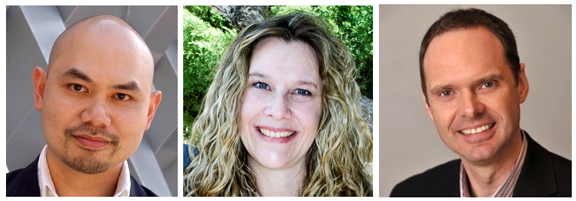
DE panel for the webcast on 3D printing and optimization: Kenneth Wong, DE’s senior editor; Simon Floyd, Microsoft’s Director, Innovation & PLM; and Michelle Boucher, Tech-Clarity’s Vice President Engineering Software Research
Latest News
June 19, 2015
 DE panel for the webcast on 3D printing and optimization: Kenneth Wong, DE’s senior editor; Simon Floyd, Microsoft’s Director, Innovation & PLM; and Michelle Boucher, Tech-Clarity’s Vice President Engineering Software Research
DE panel for the webcast on 3D printing and optimization: Kenneth Wong, DE’s senior editor; Simon Floyd, Microsoft’s Director, Innovation & PLM; and Michelle Boucher, Tech-Clarity’s Vice President Engineering Software ResearchAdditive manufacturing (AM) or 3D printing was once a prototyping technology, meant for making low-volume physical mockups. But in the last five years, it has gradually morphed into an alternative manufacturing method. Its capability to build complex shapes well outside the range possible with traditional machining or injection molding is tantalizing, especially to aerospace and automotive manufacturers.
These industries lead the charge in topology optimization. As part of their strategy to keep planes and vehicles as light as possible, car and plane makers use mathematically optimal shapes. But the algorithm-driven, software-recommended optimal shapes seldom come in perfect squares, rectangles, and circles; they are almost always in organic, unorthodox geometry. Could AM or 3D printing be the solution to manufacturing optimal topology?
To explore the link between topology optimization and 3D printing in DE‘s webcast scheduled for next Thursday, June 25, I join:
- Simon Floyd, Microsoft‘s director of business development & strategy for product lifecycle management
- Michelle Boucher, Tech-Clarity‘s VP of engineering software research
Traditionally, engineers’ foolproof method to prevent product failure has been over-engineering—by designing the product to survive the worst case scenarios (and more). But topology optimization introduces a more reasonable alternative. Michelle pointed out it helps “avoid over engineering by applying material only where needed.”
With her wide-angle view of the industry, Michelle will trace the growth of 3D printing over time, along with the advantages it offers in the range of geometry and the choice of materials. She observed, “Design rules of thumb are based on traditional manufacturing approaches. So now we need new approaches to design.”
To register for the webcast, please visit this link.
Subscribe to our FREE magazine, FREE email newsletters or both!
Latest News
About the Author
Kenneth Wong is Digital Engineering’s resident blogger and senior editor. Email him at [email protected] or share your thoughts on this article at digitaleng.news/facebook.
Follow DE





